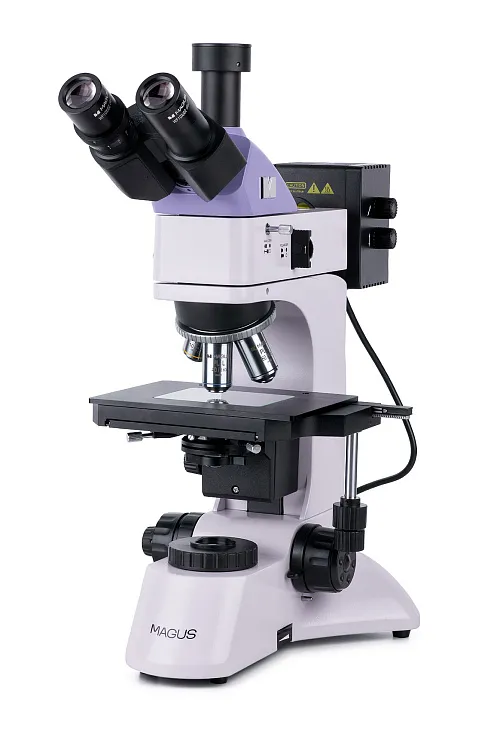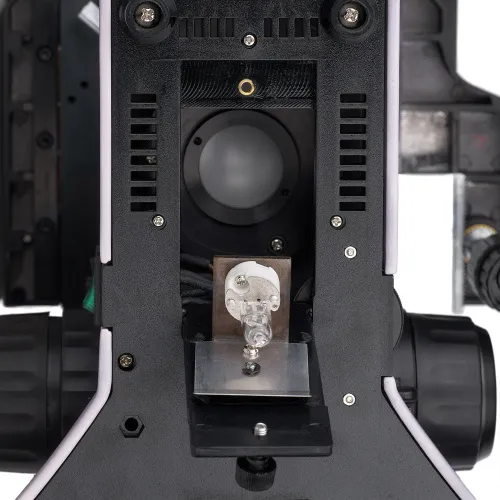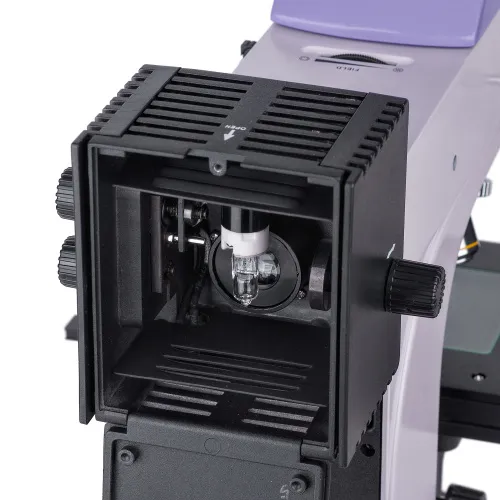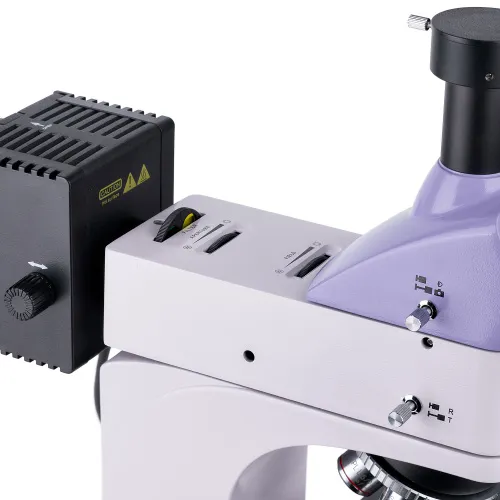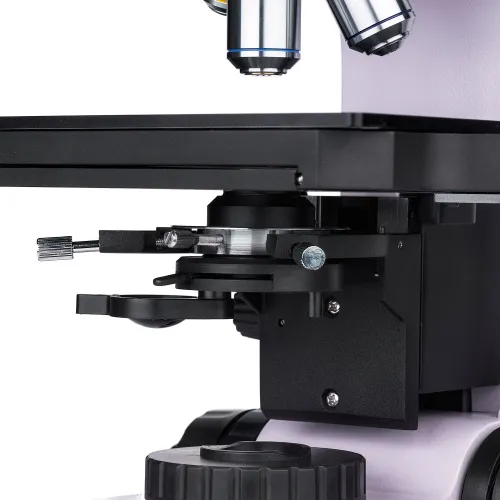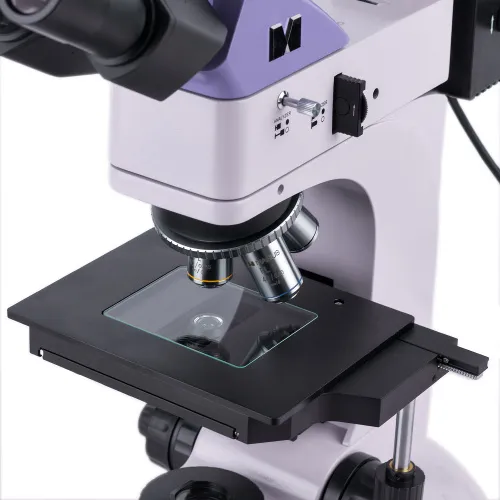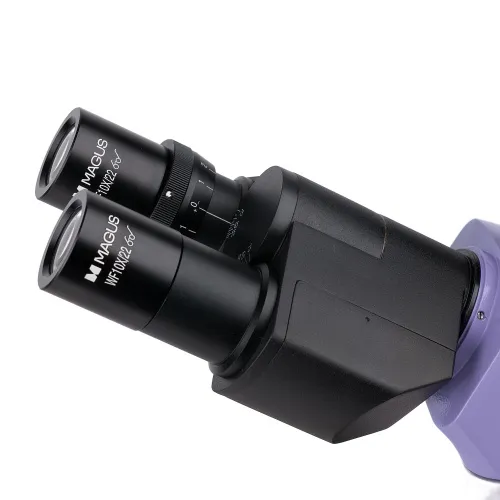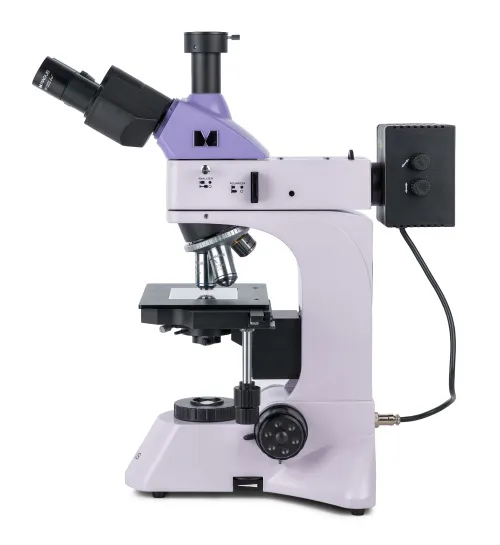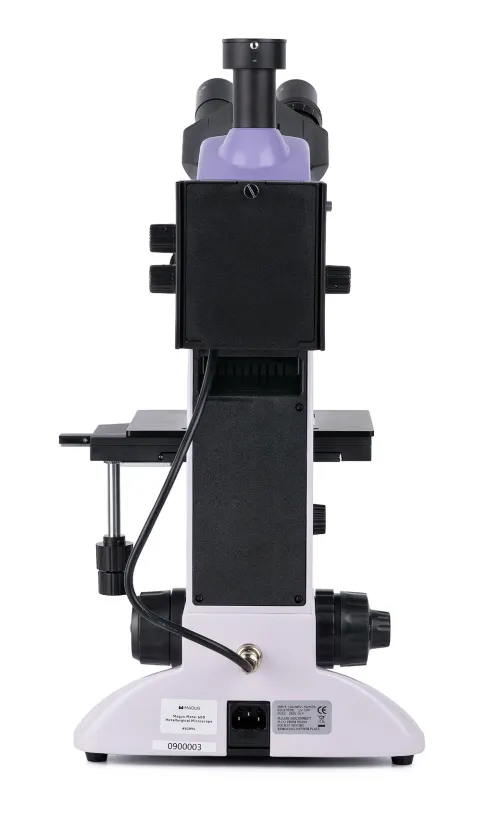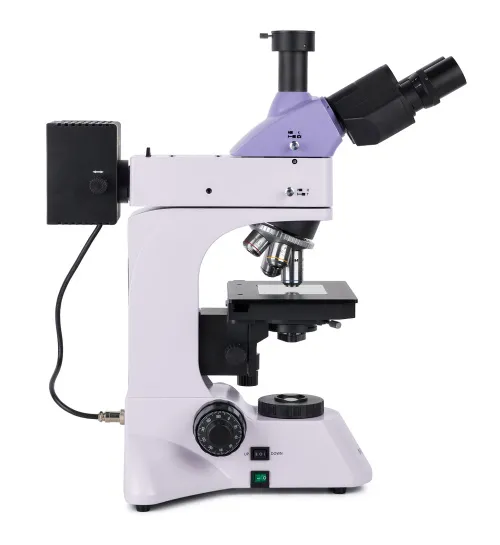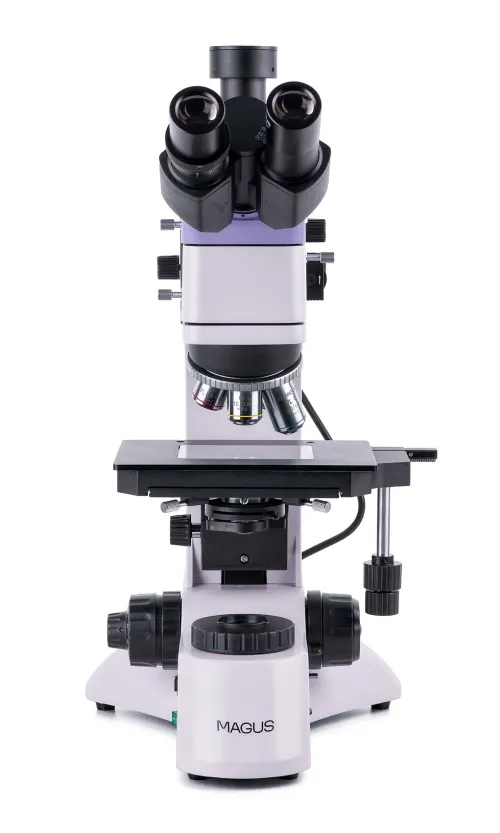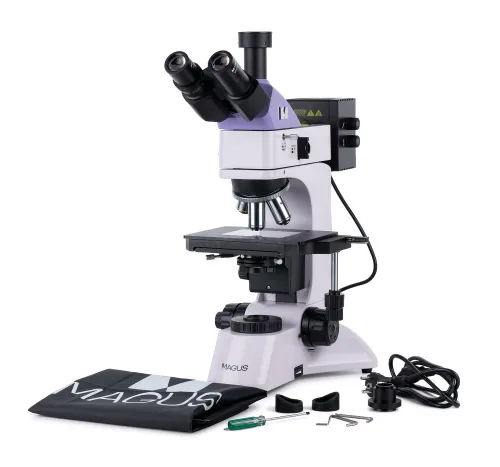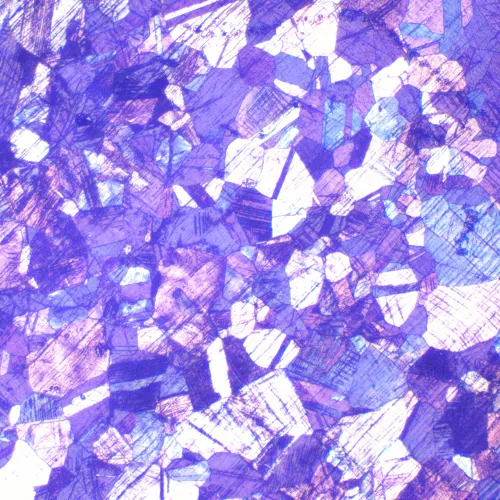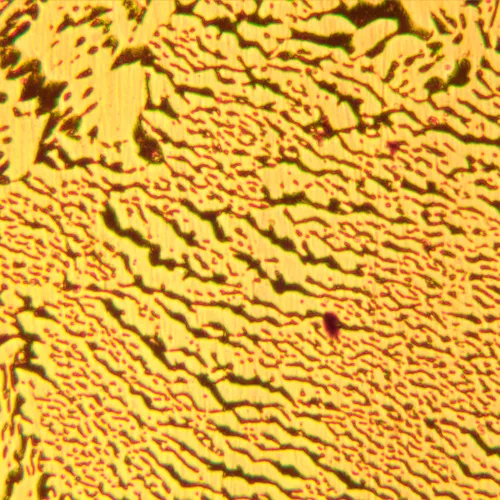MAGUS Metal 600 Metallurgical Microscope
Magnification: 50–600х. Trinocular head, plan achromatic objectives, 30W halogen transmitted and reflected light illumination
| Product ID | 82896 |
| Brand | MAGUS |
| Warranty | 5 years |
| EAN | 5905555018263 |
| Package size (LxWxH) | 35x30x75 cm |
| Shipping Weight | 14.5 kg |
Metallurgical microscope MAGUS Metal 600 is designed for studying opaque samples (metals, alloys, paint coatings, semiconductor and other materials) in reflected light using brightfield and polarization microscopy techniques. You can study the microstructures on flat and polished samples. The transmitted light illuminator also makes it possible to examine the particles trapped on filters and translucent materials (like thin films) under the microscope. The microscope is suitable for the research and analysis conducted by geologists, metallurgists, engineers, archaeologists, and specialists in other fields of science.
Optics
The trinocular head is equipped with a trinocular tube for camera mounting (not included). The light beam can be split in two positions: 100:0 or 0:100, which means you can direct the light beam to either the digital camera or the eyepiece tube. The trinocular head is 30° inclined, which is convenient for long observations. There is a diopter adjustment ring on the left tube.
In the basic configuration, the microscope magnification ranges from 50x to 600x. In order to increase the upper magnification limit, you can mount additional eyepieces. The revolving nosepiece with objectives is oriented toward the interior. Five objectives can be mounted at the same time – four of them are included in the kit and one slot is free for installing an additional one. The microscope uses plan achromatic objectives with a long working distance suitable for brightfield microscopy.
Illumination
The microscope is equipped with transmitted and reflected light illumination systems. Both use 30W brightness-adjustable halogen bulbs powered by an AC power supply. Halogen bulbs emit light with a color temperature that allows for comfortable work.
The microscope is equipped with polarization devices for reflected light observations: built-in analyzer and removable polarizer. The aperture and field diaphragms make it possible to set up the Köhler illumination, and there are also color filters included in the kit. The apertures and the reflected light source can be centered.
The transmitted light illumination system uses a traditional Abbe condenser, the position of which can be adjusted in two ways: centered and adjusted in height. It is complemented by a flip-up lens for use with low magnification objectives. There are aperture and field diaphragms, i.e., you can use the Köhler illumination method.
Stage and focusing mechanism
The maximum height of the specimen that can be put on the stage is 20mm. The specimen is moved by moving the stage along the two axes. It is complemented by a glass plate that is used for working with opaque specimens.
Coarse and fine focusing mechanisms are used for focus adjustment. Focusing is smooth and precise. The coarse focusing has a lock knob and tension adjustment. The focusing knobs are coaxially positioned on both sides so that you do not have to hold your hands in the air while working; instead, you can place them on the table.
Accessories
The MAGUS Metal 600 microscope can be further equipped with additional eyepieces, long working distance objectives, digital cameras, and calibration slides.
Key features:
- Microscope for studying opaque flat and polished samples in reflected light and translucent samples in transmitted light
- Trinocular head with a trinocular tube and a beam splitter
- Transmitted and reflected light source: 30W halogen bulb
- Köhler illumination method in transmitted and reflected light, polarization microscopy technique in reflected light
- Elements (diaphragms and light sources) of the reflected light illumination system that can be centered, set of filters
- Abbe condenser with flip-up lens that is used with low magnification objectives
- Wide range of additional objectives and eyepieces
The kit includes:
- Base with a power input, transmitted light source and condenser, focusing mechanism, stage and revolving nosepiece
- Reflected light illuminator with a lamphouse
- Trinocular head
- Infinity plan achromatic objective: PL L5x/0.12 WD 26.1mm
- Infinity plan achromatic objective: PL L10х/0.25 WD 20.2mm
- Infinity plan achromatic objective: PL L40х/0.60 WD: 3.98mm
- Infinity plan achromatic objective: PL L60x/0.70 WD: 2.08mm
- Eyepiece 10x/22mm with long eye relief (2 pcs.)
- Glass stage plate
- C-mount adapter 1x
- Hex key wrench
- AC power cord
- Reflected light illuminator power cord
- Dust cover
- User manual and warranty card
Available on request:
- 10x/22mm eyepiece with a scale
- 12.5x/14mm eyepiece (2 pcs.)
- 15x/15mm eyepiece (2 pcs.)
- 20x/12mm eyepiece (2 pcs.)
- 25x/9mm eyepiece (2 pcs.)
- Infinity plan achromatic objective: PL L20х/0.40 WD 8.80mm
- Infinity plan achromatic objective: PL L50х/0.70 WD 3.68mm
- Infinity plan achromatic objective: PL L80x/0.80 WD: 1.25mm
- Infinity plan achromatic objective: PL L100x/0.85 (dry) WD 0.40mm
- Digital camera
- Calibration slide
| Product ID | 82896 |
| Brand | MAGUS |
| Warranty | 5 years |
| EAN | 5905555018263 |
| Package size (LxWxH) | 35x30x75 cm |
| Shipping Weight | 14.5 kg |
| Type | light/optical, metallurgical |
| Microscope head type | trinocular |
| Head | Siedentopf |
| Head inclination angle | 30 ° |
| Magnification, x | 50 — 600 |
| Magnification, x (optional) | 50–1000/1250/1500/2000/2500 |
| Eyepiece tube diameter, mm | 30 |
| Eyepieces | 10х/22mm, eye relief: 10mm (*optional: 10x/22mm with scale, 12.5x/14; 15x/15; 20x/12; 25x/9) |
| Objectives | infinity plan achromatic: PL L5x/0.12, PL L10x/0.25, PL L40x/0.60, PL L60x/0.70; parfocal distance 45mm (*optional: PL L20x/0.40, PL L50x/0.70, PL L80x/0.80, PL L100x/0.85 (dry)) |
| Revolving nosepiece | for 5 objectives |
| Working distance, mm | 26.1 (5x); 20.2 (10x); 3.98 (40x); 2.08 (60x); 8.80 (20x); 3.68 (50x); 1.25 (80x); 0.40 (100x) |
| Interpupillary distance, mm | 48 — 75 |
| Stage, mm | 210x140 |
| Stage moving range, mm | 75/50 |
| Stage features | two-axis mechanical stage, with a glass plate |
| Eyepiece diopter adjustment, diopters | ±5 (on the left tube) |
| Condenser | transmitted light: center-adjustable and height-adjustable Abbe condenser, NA 1.25, adjustable aperture diaphragm and flip-down lens, with locking screws |
| Focus | coaxial, coarse focusing (25mm, with a lock knob and tension adjusting knob) and fine focusing (0.002mm) |
| Illumination | halogen |
| Brightness adjustment | ✓ |
| Power supply | 220±22V, 50Hz, AC network |
| Light source type | reflected and transmitted light: 12V/30W |
| Light filters | green, blue, yellow, matt |
| Operating temperature range, °C | 5...+35 |
| Additional | built-in analyzer and removable polarizer |
| User level | experienced users, professionals |
| Assembly and installation difficulty level | complicated |
| Application | metallurgical |
| Illumination location | dual |
| Research method | bright field, polarization |
| Pouch/case/bag in set | dust cover |
| Weight, kg | 11 |
We have gathered answers to the most frequently asked questions to help you sort things out
Find out why studying eyes under a microscope is entertaining; how insects’ and arachnids’ eyes differ and what the best way is to observe such an interesting specimen
Read this review to learn how to observe human hair, what different hair looks like under a microscope and what magnification is required for observations
Learn what a numerical aperture is and how to choose a suitable objective lens for your microscope here
Learn what a spider looks like under microscope, when the best time is to take photos of it, how to study it properly at magnification and more interesting facts about observing insects and arachnids
This review for beginner explorers of the micro world introduces you to the optical, illuminating and mechanical parts of a microscope and their functions
Short article about Paramecium caudatum - a microorganism that is interesting to observe through any microscope

